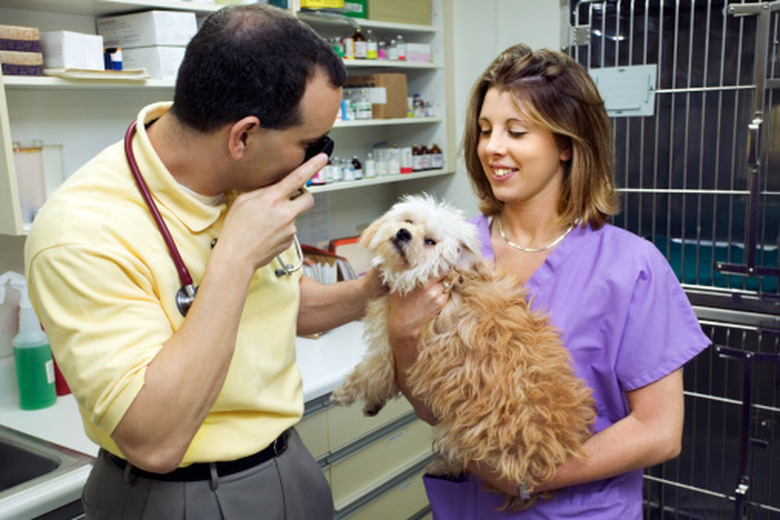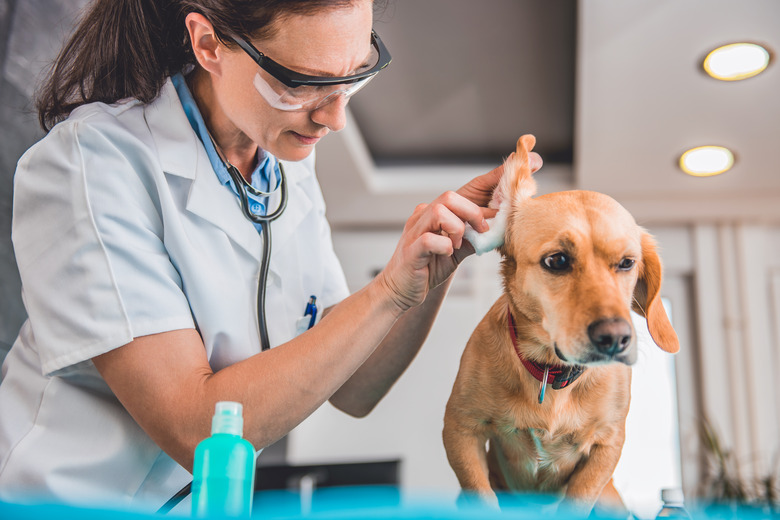What Causes Brown Scaly Scabs On A Dog's Ears?
Every dog loves a good ear rub, but it's not much fun when the dog develops scabs inside their ears. Dark, scaly spots or lesions can develop inside and around a canine's ears for a variety of reasons. While a couple of minor scabs from rough and tumble play may not be cause for concern, scabs in a dog's ears can signify a more serious underlying cause that needs treatment from a veterinarian.
Why are there crusty scabs on my dog's ear?
Why are there crusty scabs on my dog's ear?
If a dog has crusty ear scabs, it's not something that should be taken lightly, especially if the ear is red or looks irritated; if there is excessive head shaking, discharge, or a foul odor; or if the dog is also showing signs of itchiness or discomfort.
If a dog is rubbing their head on the carpet or furniture, pawing or scratching at their ears, or having trouble hearing, a visit to the veterinarian is in order. Ear issues in dogs can be very uncomfortable or even painful, and in some cases, they can be dangerous, so dog owners need to have the problem properly diagnosed as the first step toward healing the dog's ear issue.
Common causes of scabs in a dog's ear
Common causes of scabs in a dog's ear
Dogs can develop scabs in their ears from a variety of conditions. These include:
- Dermatitis
- Ear infections
- Allergies
- Injury or trauma
- Fleas and mites
Ear dermatitis in dogs
Ear dermatitis is a term used to describe skin inflammation on a dog. Ear dermatitis is commonly seen in the ear area and around the face. Primary symptoms may include:
- Irritation
- Intense itching
- Swelling
- Redness
- Crusting
- Hair loss
Dogs with ear dermatitis may scratch at their ear or rub their face on the carpet, and their ear flaps may appear red and irritated. They may have dark, waxy discharge from their ear, and the skin there may appear raw, crusty, or flaky. Dermatitis in dogs most commonly develops between ages 1 and 5.
Ear infections in dogs
Ear infections are fairly common in dogs, as the shape of a dog's ear makes them more prone to ear infections than humans. Dog breeds with floppy ears are especially prone to ear infections. These infections are generally caused by bacteria and/or yeast.
Ear infections are divided into three types:
- Otitis externa: This is the most common type of ear infection, in which inflammation impacts the outer ear canal.
- Otitis media: This is an infection of the middle ear. Infections in the external part of the ear can spread to the middle ear if not treated.
- Otitis interna: This
is an infection of the inner ear canal, and it is the most dangerous
type of infection. If left untreated, it can lead to balance issues,
deafness, and/or facial paralysis.
While scabs and rough, scaly skin on the inside of the ear are generally quite obvious in the case of otitis externa, any ear infection will induce discomfort and itching. This may cause the dog to scratch at the ear or rub it on other surfaces to get relief, leading to the formation of scabs.
Ear infections can be serious and require a visit to a veterinarian. Depending on the severity and location of the infection, it may require a medicated cleaner, oral antibiotics, and anti-inflammatory medications. Bacterial infections will generally require antibiotics, while fungal infections require anti-fungal medication.
The most effective way to prevent ear infections in dogs is through regular ear cleaning. Do not use hydrogen peroxide or alcohol; rather, select an over-the-counter cleaner designed specifically for dogs' ears and use a cotton ball to gently swab the ear.
Crusty ear scabs caused by dog allergies
Allergies are a common cause of ear scabs. This may include allergies to fleas or certain food proteins or environmental allergens, such as grass, pollen, or mold.
If a dog develops crusty ear scabs and itching only at certain times of the year, this may be due to an environmental allergy (atopic dermatitis). If the dog has chronic or recurrent ear issues that happen throughout the year, this may be caused by food allergies.
Dogs with allergies are more prone to getting ear infections, so discovering the source of the allergen is important in order to prevent chronic ear disease.
Injuries to a dog's ear
Sometimes, scabs in a dog's ear are signs of infection or allergies; other times, they are just what they appear to be. If a dog attends doggie day care or there are other dogs in the home, minor scabs can be caused by scratching, biting, and normal dog play. Scabs can also be caused by dry skin, bug bites, minor scrapes, or burns. There are home remedies for dry skin, and minor injuries will generally heal on their own, but they need to be watched to ensure they don't become infected, especially if the dog is scratching at them.
Symptoms of ear mites: Scabs in your dog's ears
Symptoms of ear mites: Scabs in your dog's ears
Ear mites (Otodectes cynotis), or minuscule creatures that can thrive inside the inner ears of household pets, are one possible cause of scabs in a dog's ears. Ear mites are parasites that feed on the wax and oils found in a dog's ears. While ear mites don't bite the skin, they make a dog's ears itchy. If a dog has ear mites, they may shake their head and scratch their ears excessively. The scratching can actually cause serious damage to the dog's ears.
If a dog has ear mites, you may notice an abrasion or scab at the base of their ear from excessive scratching. Bacteria can get into the open wound, resulting in an infection. In serious cases, ear mites can affect other parts of the dog's body. A dog can also develop a blood blister, called a hematoma, within the flap of the ear from scratching or shaking their head.
Identifying a possible ear mite infestation in dogs
Identifying a possible ear mite infestation in dogs
Ear mites are highly contagious. Dogs get ear mites when they have direct contact with another infested dog or cat. Ear mites are tiny; they are barely visible to the naked eye. If a dog has ear mites, you may notice dark debris resembling coffee grounds in their ears. Ear mites can also cause a dog's ears to smell foul.
Redness in or around a dog's ears is a sign of many possible things, one of which is an ear mite infestation. Ear mites are more common in cats than dogs, so for those who feed stray cats, it's important to keep them separate from your dog or cat to avoid potentially picking up ear mites from them.
In severe infestations, there may be pus or discharge coming from the dog's ears. If ear mites are suspected, it's important to take the dog to a veterinarian.
Diagnosing and treating ear mites in dogs
Diagnosing and treating ear mites in dogs
If left untreated, ear mites can lead to more serious problems, so always take the dog to the veterinarian to confirm a suspected diagnosis of ear mites. Only medical professionals can determine the severity of the dog's case and provide necessary treatment. The veterinarian will make a diagnosis using an otoscope to look into the dog's ears and by examining discharge from the dog's ears under a microscope.
There are several medications used to treat ear mites. Some require daily application, while others are single-use products. The veterinarian will choose the best medication for the dog based on the situation.
Preventing ear mites in dogs
Preventing ear mites in dogs
The best way to prevent ear mites is by keeping the dog away from other animals that have them. If your dog gets ear mites and you have more than one pet, separate the infested dog from the rest of the pets. The veterinarian will likely recommend treating all the pets in the home for ear mites if one of them is infested.
Some products that protect a dog from getting fleas can also protect them from ear mites. A veterinarian can answer any questions about these products and provide a prescription as needed. Cleaning a dog's ears regularly will also help to stay on top of any potential ear issues.
The bottom line
The bottom line
There are a variety of reasons a dog may develop crusty ear scabs. Allergies, dermatitis, ear infections, injuries, or ear mites can all cause these scabs. Scratching can make the situation worse. Ear issues are extremely uncomfortable and, in some cases, dangerous. For that reason, it's important to always take your dog to your DVM if you suspect an ear problem.

